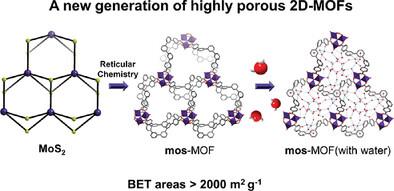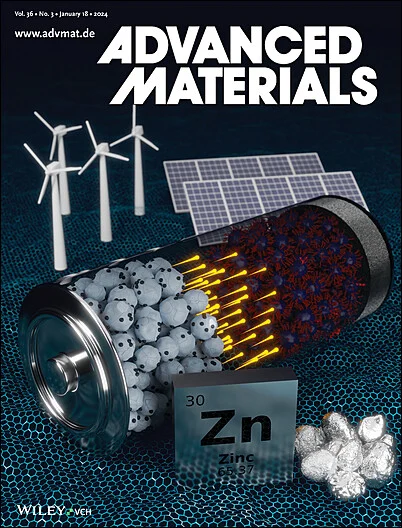具有固有层内孔隙率的双周期 MoS2 型金属有机框架可实现高吸水能力
IF 27.4
1区 材料科学
Q1 CHEMISTRY, MULTIDISCIPLINARY
引用次数: 0
摘要
二维金属有机框架(2D-MOFs)是一类重要的功能性多孔材料。然而,二维金属有机框架的低孔隙率和低比表面积极大地限制了其功能和应用。本文报道了基于三核金属团簇和 3 连接三足有机配体组装的二硫化钼(mos)网的一类 mos-MOFs 的合理合成。非结晶(3,6)连接的 mos 网不同于石墨烯的 3 连接 hcb 网,它将一个节点分成两个,从而提供了丰富的层内空隙。事实上,mos-MOFs 表现出很高的表观布鲁瑙尔-艾美特-泰勒表面积,明显优于其他二维-MOF 类似物。值得注意的是,在 298 K 和 P/P0 = 0.9 条件下,水解稳定的 Cr-mos-MOF-1 的水蒸气吸收量高达 0.75 g-1,是二维-MOF 中最高的。结合水吸附和 X 射线衍射研究揭示了水吸附机理,表明了 mos-MOFs 层内孔隙对于高性能水捕获的重要性。这项研究为合成具有高孔隙率和高比表面积的二维-MOFs铺平了道路,使其能应用于多种领域。本文章由计算机程序翻译,如有差异,请以英文原文为准。

Two-Periodic MoS2-Type Metal–Organic Frameworks with Intrinsic Intralayer Porosity for High-Capacity Water Sorption
2D metal–organic frameworks (2D-MOFs) are an important class of functional porous materials. However, the low porosity and surface area of 2D-MOFs have greatly limited their functionalities and applications. Herein, the rational synthesis of a class of mos-MOFs with molybdenum disulfide (mos) net based on the assembly of trinuclear metal clusters and 3-connected tripodal organic ligands is reported. The non-crystallographic (3,6)-connected mos net, different from the 3-connected hcb net of graphene, offers abundant intralayer voids courtesy of the split of one node into two. Indeed, mos-MOFs exhibit high apparent Brunauer-Emmett-Teller surface areas, significantly superior to those of other 2D-MOF analogs. Markedly, hydrolytically stable Cr-mos-MOF-1 displays an impressive water vapor uptake of 0.75 g g−1 at 298 K and P/P0 = 0.9, among the highest in 2D-MOFs. The combined water adsorption and X-ray diffraction study reveal the water adsorption mechanisms, suggesting the importance of intralayer porosities of mos-MOFs for high-performance water capture. This study paves the way for a reliable approach to synthesizing 2D-MOFs with high porosity and surface areas for diverse applications.
求助全文
通过发布文献求助,成功后即可免费获取论文全文。
去求助
来源期刊

Advanced Materials
工程技术-材料科学:综合
CiteScore
43.00
自引率
4.10%
发文量
2182
审稿时长
2 months
期刊介绍:
Advanced Materials, one of the world's most prestigious journals and the foundation of the Advanced portfolio, is the home of choice for best-in-class materials science for more than 30 years. Following this fast-growing and interdisciplinary field, we are considering and publishing the most important discoveries on any and all materials from materials scientists, chemists, physicists, engineers as well as health and life scientists and bringing you the latest results and trends in modern materials-related research every week.
 求助内容:
求助内容: 应助结果提醒方式:
应助结果提醒方式:


